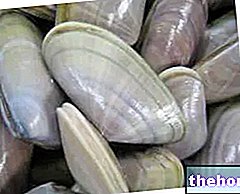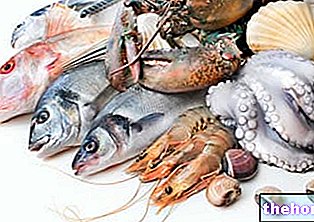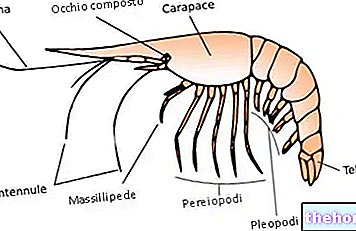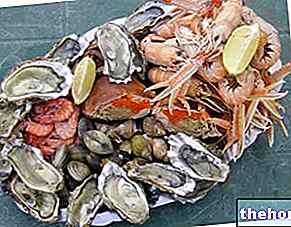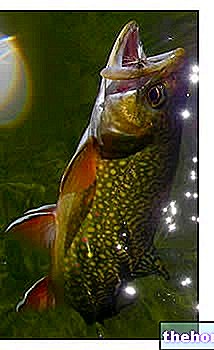On the other hand, sea limpets are not all the same. The species of greatest food interest for man - to which we will refer in this article - is the P. ferruginea, which populates the coasts of the Western Mediterranean Sea and is more abundant in Corsica, Sardinia, Morocco, Algeria and Southern Spain; unfortunately, today it is considered to be at risk of extinction. Other popular limpets are: P. nigra, P. ulyssiponensis etc.
From a nutritional point of view, the sea limpet belongs to the 1st fundamental group of foods. The bibliography does not offer much information on its chemical content but it is likely to think that it is low in fat and low in calories, even if rich in proteins of high biological value. The vitamin profile of the water-soluble group B is satisfactory, as is the contribution of certain minerals - for example iodine.
Known for its delicacy, the limpet is enjoyed by connoisseurs above all raw, often picked and eaten on the spot.
which falls within the 1st fundamental group of foods. Once part of the poor fish category, today it is a luxury ingredient because it is very difficult to find - being protected.
The limpet is probably a low-energy food, nutritional properties mainly due to the modest lipid concentration, despite the excellent protein intake. Calories are therefore mainly supplied by peptides, followed by little relevant concentrations of lipids and irrelevant or almost irrelevant carbohydrates. Proteins they are of high biological value - they contain all the essential amino acids compared to the human model - the fatty acids are mainly unsaturated - as we anticipated, with an excellent percentage of the biologically active semi-essential omega 3 polyunsaturated EPA and DHA - and the carbohydrates are simple.
Fibers are absent and cholesterol should be well present. Lactose and gluten are completely absent. The concentration of purines is abundant, while histamine should be moderate. Being a high protein food, it is also a significant source of the amino acid phenylalanine. The patella should be rich in water-soluble B vitamins and probably also vitamin D (calciferol) Among the minerals, in addition to iodine, it is presumed that the concentrations of iron and phosphorus can be interesting.
The limpet is an organism that feeds on algae, therefore the accumulation of mercury and methylmercury is limited; on the other hand, raw consumption is potentially subject to contamination by hepatitis A virus, Vibrio cholerae, Salmonella typhi And paratyphi etc.
, is inadequate to the diet of subjects with digestive complications such as dyspepsia, gastritis, gastroesophageal reflux disease, gastric or duodenal ulcer. Patella is a food suitable for slimming diets, which must be low-calorie and normolipidic. Being very lean, this mollusk can be cooked using extra virgin olive oil also in nutritional therapy against obesity. The abundance of proteins with a high biological value makes it the ideal limpet in the diet of malnourished, defied or with an increased need for essential amino acids. . This type of food is recommended in the case of very high intensity motor sports, especially in strength disciplines or with a very important hypertrophic muscle component, and for all particularly prolonged aerobic disciplines. The patella is also suitable in cases of breastfeeding, pathological intestinal malabsorption and in the elderly - in which the eating disorder and decreased intestinal absorption tend to create a protein deficit. EPA and DHA, semi-essential but biologically active omega 3, are very important for:
- The constitution of cell membranes
- The development of the nervous system and eyes - in the fetus and children
- The prevention and treatment of some metabolic diseases - hypertriglyceridemia, arterial hypertension, etc.
- The maintenance of cognitive functions in old age
- The reduction of some symptoms of neurosis - depressive, etc.
Due to the absence of gluten and lactose, the patella is relevant in the diet for celiac disease and for milk sugar intolerance. The abundance of purines makes it unwanted, in considerable portions, in the nutritional regimen for hyperuricemia, especially of severe entity - with gouty attacks - and in that for kidney stones or uric acid lithiasis. As for the "intolerance to" histamine, on the other hand, if perfectly preserved, it has no contraindications. The massive presence of phenylalanine precludes its use in the diet against phenylketonuria.
The B vitamins have a mainly coenzyme function; this is why the patella can be considered a good source of nutrients that support the cellular functions of all tissues. The D, on the other hand, is crucial for bone metabolism and for the immune system. Note: remember that food sources of vitamin D are very rare. Phosphorus, hardly lacking in the diet, is one of the main constituents of bone (hydroxyapatite) and nervous (phospholipids) tissue. Finally, iodine is necessary for the proper functioning of the thyroid gland - responsible for regulating cellular metabolism after secreting the hormones T3 and T4.
Patella meat is allowed in the diet during pregnancy, as long as it is cooked and comes from safe sources. In this case it would still be a good idea to limit their consumption to a one-off time. The average portion of limpet - as a dish - is less than 100 g.
type A, a viral disease, cholera, salmonella and typhoid fever.
Then, having to cook them in a pan or in a saucepan, to prevent them from releasing impurities, as is done for mussels, oysters and large sea snails, it is essential to clean the surface by removing algae and encrustations such as dog teeth or "gramostini" .
The most basic method of cooking limpets is drowning; then dip the limpets in boiling water for 5 minutes. At this point they can be eaten naturally, simply removing them from the shell, taking care to eliminate the innermost part of the mollusk - the one just under the shell - with the help of a knife and fork, or season with oil, possibly lemon juice or even with chopped parsley, garlic, salt and pepper.
Many, on the other hand, sauté them further in the pan - shelled or whole - blended with white wine and seasoned with oil, garlic and parsley, or with mint and marjoram, or with tomato sauces or other vegetables - even spicy. With the limpets you can make first courses, for example the classic linguine, of excellent quality, or the fantastic risottos. The large limpets - 7 or 10 cm - can also be grilled or au gratin in the oven - for a few minutes, preventing them from hardening.
which, to defend itself from predators or to survive the low tide, by contracting, lowers the shell and closes the slit - normally open to allow the recirculation of water, essential for breathing and to maintain hydration.The limpets reproduce between spring and autumn, releasing initially planktonic larvae which then adhere to the rocks; these creatures are born males and become females 5-6 centimeters in diameter. In addition to man, they are an extremely sought after prey by many species. of fish.


